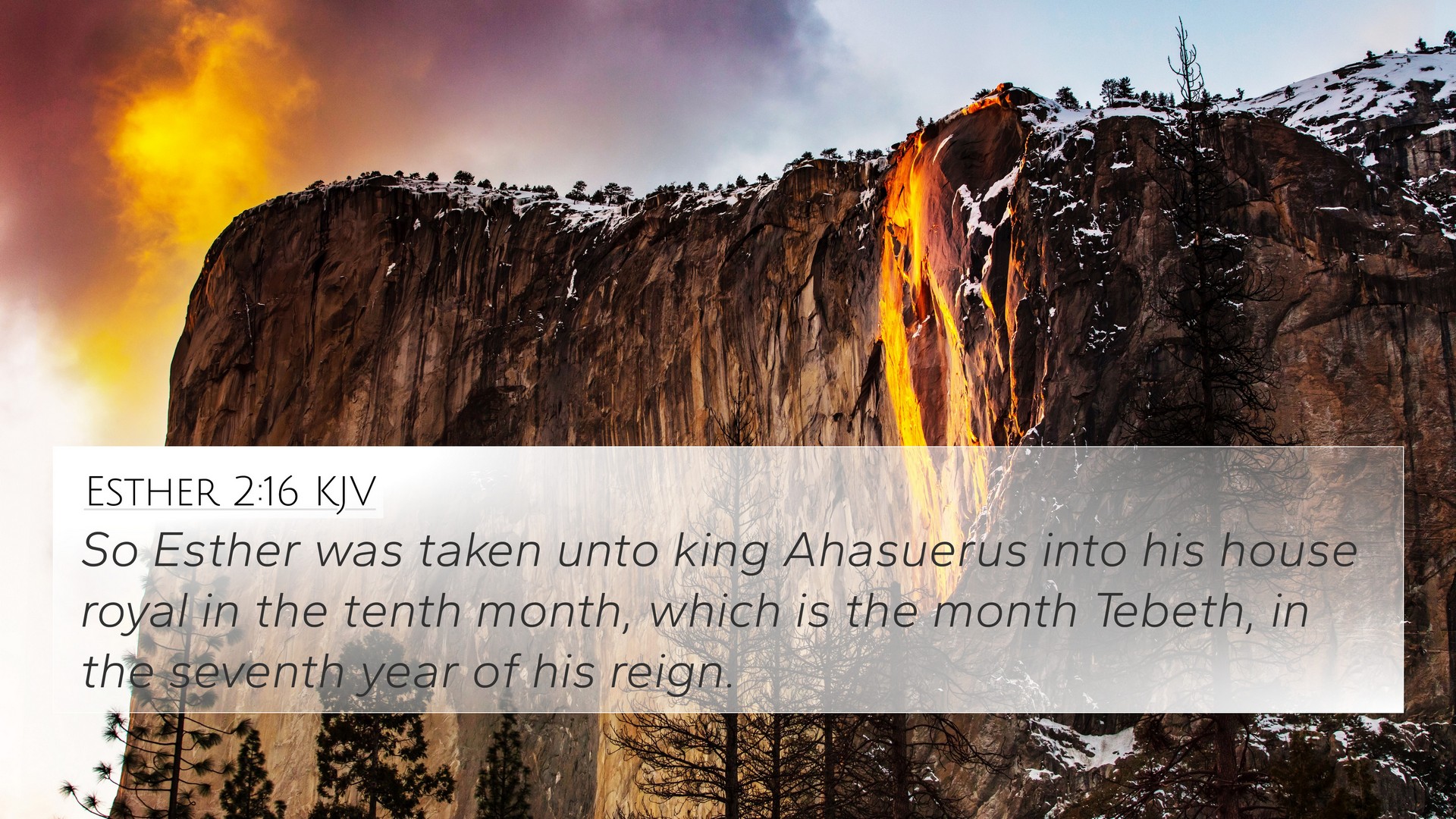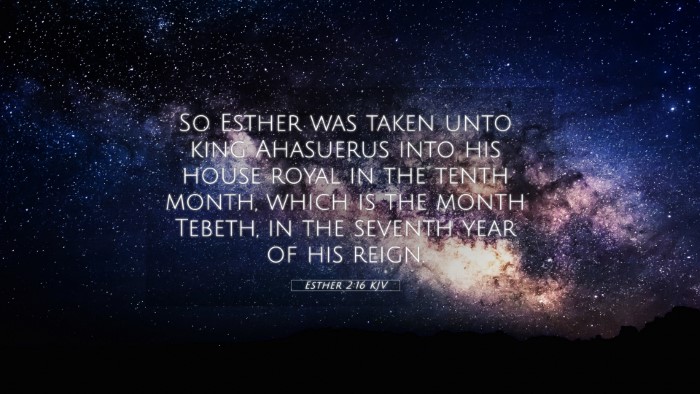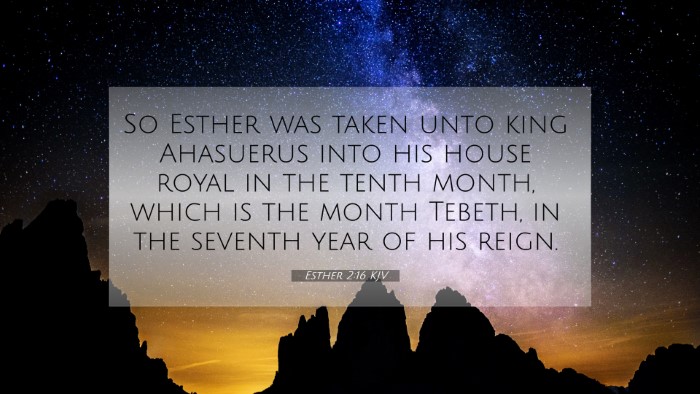Old Testament
Genesis Exodus Leviticus Numbers Deuteronomy Joshua Judges Ruth 1 Samuel 2 Samuel 1 Kings 2 Kings 1 Chronicles 2 Chronicles Ezra Nehemiah Esther Job Psalms Proverbs Ecclesiastes Song of Solomon Isaiah Jeremiah Lamentations Ezekiel Daniel Hosea Joel Amos Obadiah Jonah Micah Nahum Habakkuk Zephaniah Haggai Zechariah MalachiEsther 2:16 Similar Verses
Esther 2:16 Cross References
So Esther was taken unto king Ahasuerus into his house royal in the tenth month, which is the month Tebeth, in the seventh year of his reign.
Uncover the Rich Themes and Topics of This Bible Verse
Listed below are the Bible themes associated with Esther 2:16. We invite you to explore each theme to gain deeper insights into the Scriptures.
Esther 2:16 Cross Reference Verses
This section features a detailed cross-reference designed to enrich your understanding of the Scriptures. Below, you will find carefully selected verses that echo the themes and teachings related to Esther 2:16 KJV. Click on any image to explore detailed analyses of related Bible verses and uncover deeper theological insights.
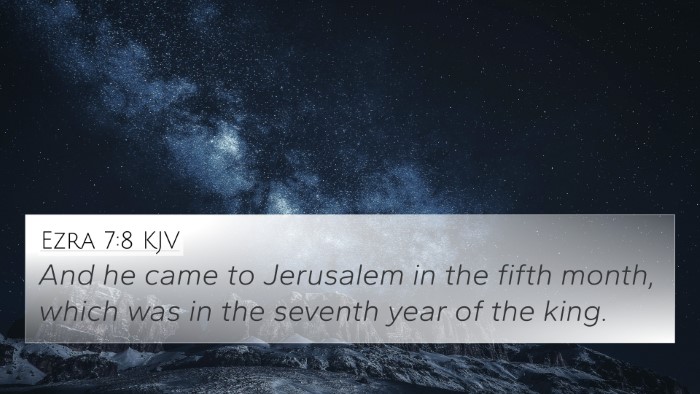
Ezra 7:8 (KJV) »
And he came to Jerusalem in the fifth month, which was in the seventh year of the king.
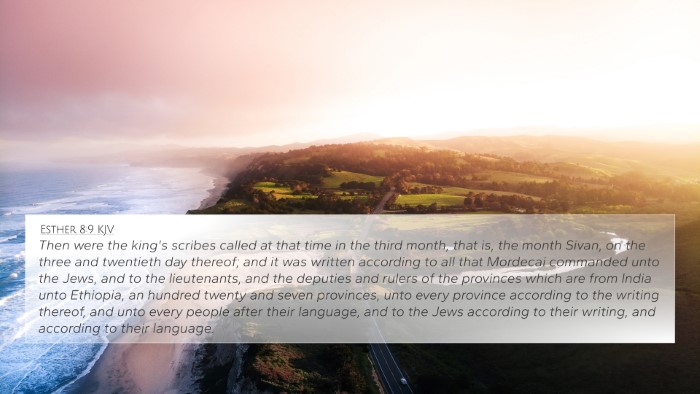
Esther 8:9 (KJV) »
Then were the king's scribes called at that time in the third month, that is, the month Sivan, on the three and twentieth day thereof; and it was written according to all that Mordecai commanded unto the Jews, and to the lieutenants, and the deputies and rulers of the provinces which are from India unto Ethiopia, an hundred twenty and seven provinces, unto every province according to the writing thereof, and unto every people after their language, and to the Jews according to their writing, and according to their language.

Esther 2:3 (KJV) »
And let the king appoint officers in all the provinces of his kingdom, that they may gather together all the fair young virgins unto Shushan the palace, to the house of the women, unto the custody of Hege the king's chamberlain, keeper of the women; and let their things for purification be given them:
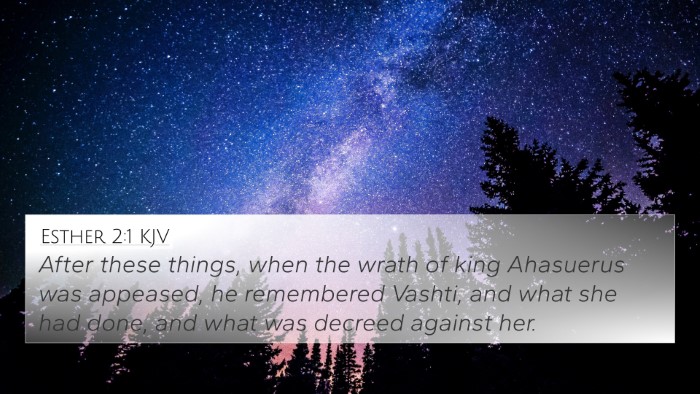
Esther 2:1 (KJV) »
After these things, when the wrath of king Ahasuerus was appeased, he remembered Vashti, and what she had done, and what was decreed against her.
Esther 2:16 Verse Analysis and Similar Verses
Understanding Esther 2:16
Esther 2:16 states, "So Esther was taken to King Ahasuerus, into his royal house, in the tenth month, which is the month of Tebeth, in the seventh year of his reign." This verse marks a significant moment in the story of Esther, presenting her transition from relative obscurity in the Jewish community to a position of potential influence and power within the Persian Empire.
Contextual Background
This verse occurs within the narrative of Esther, which is set during the reign of King Ahasuerus (Xerxes I), a time marked by the Jewish exile in Persia. The story unfolds the providence of God in the lives of His people, particularly through Esther, a Jewish orphan, who becomes queen.
Significance of Esther 2:16
- Divine Providence: The verse illustrates how God orchestrates events to fulfill His purpose. Esther's selection as queen is not coincidental but part of God's plan for the Jewish people.
- Timing: The mention of the tenth month, Tebeth, signifies a specific time in the Jewish calendar, emphasizing the importance of God's timing in fulfilling His purposes.
- Identity: Esther's journey to become queen reflects themes of identity and the tension between her Jewish heritage and her life in the Persian court.
Commentary Insights
Various public domain commentaries offer insightful interpretations of this verse:
- Matthew Henry: Henry emphasizes the providential nature of Esther's rise to royalty, suggesting that God prepares His servants for the roles they are meant to play in His kingdom.
- Albert Barnes: Barnes notes the significance of the specific timeframe and connects it to the fulfillment of God's promises to the Israelites, enhancing the notion that God is at work even in secular settings.
- Adam Clarke: Clarke provides a detailed historical background about the Persian Empire and its customs, which helps elucidate the cultural challenges Esther faced as a Jew in a foreign land.
Bible Verse Cross-References
Esther 2:16 can be cross-referenced with several biblical texts that highlight similar themes of divine purpose and the rise of unlikely leaders:
- Proverbs 21:1: "The king's heart is in the hand of the Lord, as the rivers of water: he turneth it whithersoever he will."
- Daniel 2:21: "And he changeth the times and the seasons: he removeth kings, and setteth up kings..."
- Romans 8:28: "And we know that all things work together for good to them that love God..."
- 1 Peter 2:9: "But ye are a chosen generation, a royal priesthood, an holy nation..."
- Isaiah 43:1: "But now thus saith the Lord that created thee, O Jacob, and he that formed thee, O Israel, Fear not: for I have redeemed thee..."
- Ephesians 2:10: "For we are his workmanship, created in Christ Jesus unto good works..."
- Psalms 75:6-7: "For promotion cometh neither from the east, nor from the west, nor from the south. But God is the judge: he putteth down one, and setteth up another."
Thematic Bible Verse Connections
This verse can also be linked with broader themes found throughout the Scriptures:
- God's Faithfulness: Just as Esther is placed in a pivotal role, numerous other scriptures illustrate God's faithfulness to His people, like in Jeremiah 29:11, where He promises a future and hope.
- Divine Appointments: Other stories of divinely appointed individuals, such as Joseph's rise to power in Genesis 41, echo the narrative of Esther.
- Deliverance: God's deliverance of His people is a recurring theme, found in Exodus 12 and expanded in the New Testament in Luke 1:68.
Tools for Bible Cross-Referencing
When studying this verse, utilizing tools for Bible cross-referencing can enhance understanding:
- Bible Concordance: A comprehensive concordance can help locate themes related to Esther.
- Bible Cross-Reference Guide: Guides often display verses with similar themes, facilitating comparative Bible verse analysis.
- Cultural Context Resources: Understanding cultural nuances, like those discussed by Adam Clarke, enriches interpretation.
Conclusion
In summary, Esther 2:16 serves not only as a historical account but as a reflection on God's sovereignty and ability to use individuals for His purposes. Through cross-referencing and thematic connections, one can gain deeper insights into the biblical text and understand the intricate ways God works within the world.
For Further Study: Exploring other biblical texts related to leadership, God's provision, and the experiences of His people can provide invaluable insights into the richness of Scripture and the overarching narrative of God's interaction with humanity.
